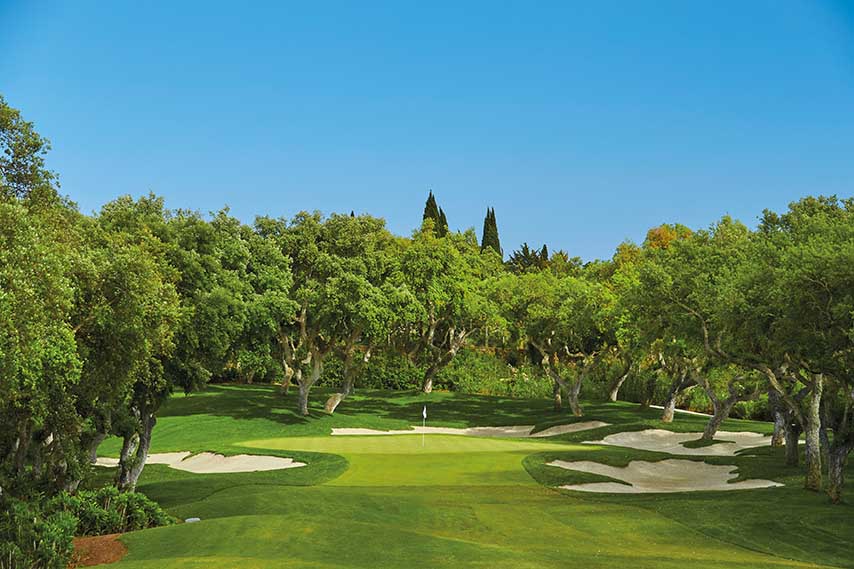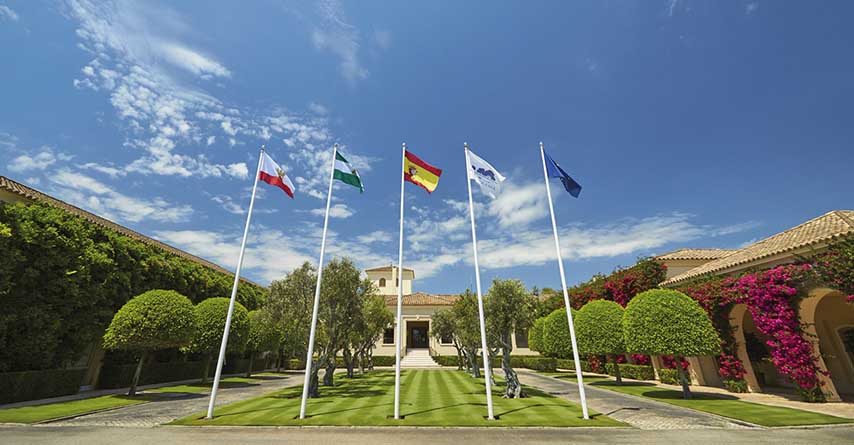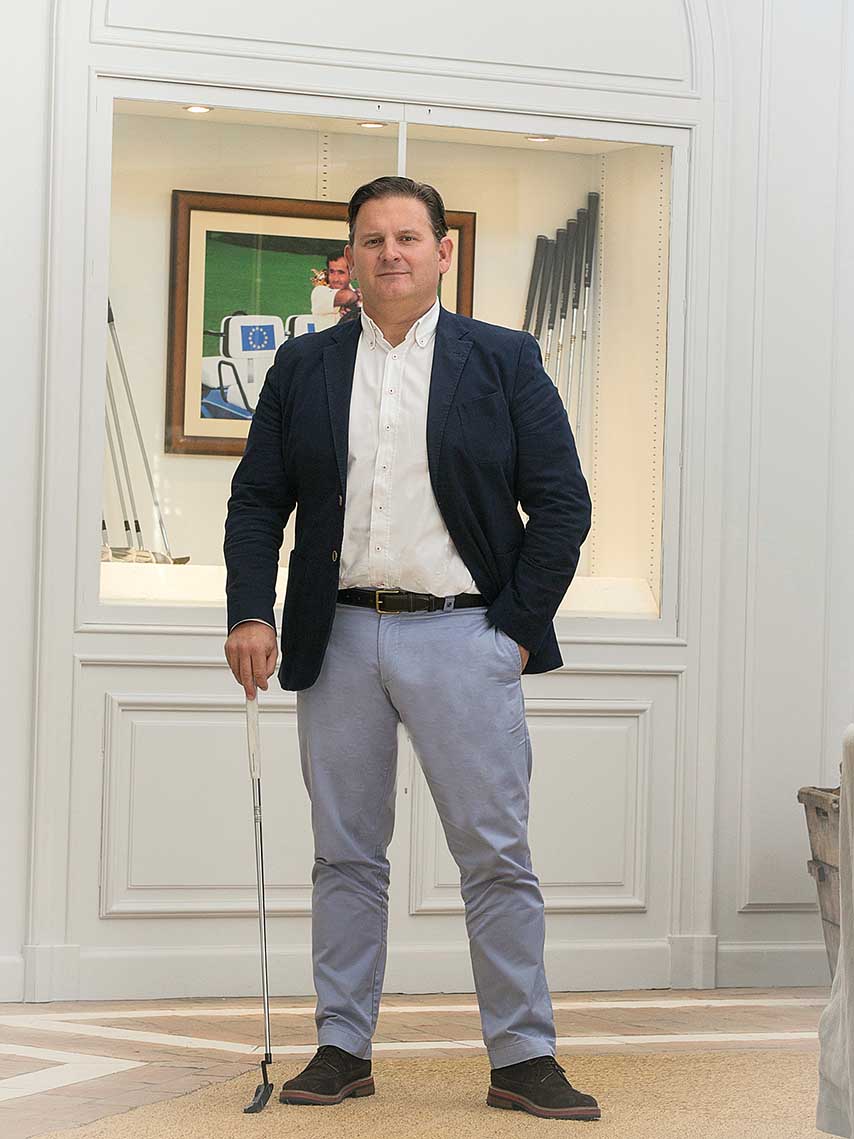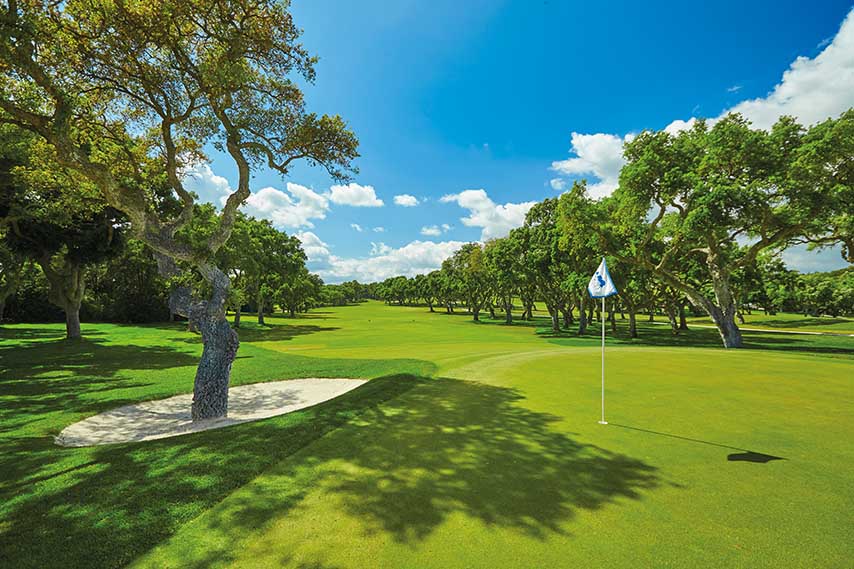It is unquestionably the best known and most deservedly highly praised Spanish golf course around the world. There are many reasons for this, but they can be essentially summarised in three: the design by legendary US architect Robert Trent Jones; maintenance that borders on perfection; and a history, forged over the past 30 years, that very few clubs can match.
There are many aspects of the course that can be highlighted to explain why Valderrama hasn’t been overtaken at the top of the ratings. In addition to the design, completed by one of the world’s most prestigious architects in the prime of his career, on a spectacular plot of land with a widely diverse landscape, it is the maintenance that particularly stands out: one facet of Valderrama that contributed to its blossoming reputation in the early years and which has since been followed by other courses throughout Europe.
At the time, the demanding standards imposed at the course – which continue to this day – were a complete novelty on the Old Continent…. remarkably innovative during that era.

Until then, in the late-‘80s and early-‘90s, nothing had ever been seen like it, and Valderrama soon became a point of reference, a standard-bearer, for other European courses. From that moment, they all sought excellence in the “manicure” and presentation of their layouts: the fairways and greens of the famous Sotogrande course became a model copied by others.
Valderrama’s modus operandi was, nevertheless, already common in the US. There were others, of course, but Augusta was the most significant example, and possibly the inspiration for Jaime Ortiz Patiño in his firm commitment to turn Valderrama into the course it is today.
Good maintenance such as that carried out at Valderrama is based on three key elements. First, of course, is knowing exactly what you are doing, especially working with the grass. To that end, an academic background is important in achieving optimum results. Then you need the appropriate team, both in size and training. And, finally, you need the right equipment, well “greased” for the work at hand.
All these prerequisites are fulfilled – and have always been fulfilled – at this exceptional course, originally opened in 1974 as Las Aves.
When Jaime Ortiz Patiño bought the course in 1985, he phoned Robert Trent Jones to ask him to re-design the layout. After this second intervention, the US designer always rated Valderrama as one of his finest projects; and, when the policy of achieving the highest level of maintenance was instituted, his devotion to the course became even more acute – and he visited Valderrama frequently.
.

MIND-BOGGLING CURRICULUM
The top clubs around the world base part of their prestige on the fact they have hosted major events.” And in that respect Valderrama is only outdone by a handful of courses in the UK, and none on the continent.
Not Augusta, not Pebble Beach, not Olympic… none of those courses would be what they are today if they had not hosted the tournaments that have enhanced their international status.
The premier events for professionals, involving the best players in the world, boost the prestige of a course, especially if they are televised and followed by millions of spectators who can check out and admire the layout – even the smallest of details.
The Volvo Masters was the first of the major tournaments held at the club, and its association with Valderrama was of immense mutual satisfaction for both parties and the foundation on which the course established its legendary status. The Volvo Masters was also a pioneering event in Europe, for many reasons, not only because it was the season-ending grand finale of the European Tour but also because of how it was run.
Once again the key word here is “excellence”. There was no other tournament like it in Europe at the time and, like the course itself, it became a point of reference for all other events.
The money spent on logistics, the meticulous organisation, the treatment enjoyed by guests and players… all of these aspects led to the tournament achieving a dazzling image that others were keen to emulate.
When, in addition to this, it is noted that the course was presented in a similar condition to that of Augusta, it is easy to understand why it rose to such a high status.
Sixteen Volvo Masters were held at Valderrama: in two separate periods, from 1988 to 1996 and 2002 to 2007. One of the significant contributions to its success was, right from the start to the end, having its own daily bulletin, always produced by Andalucía Golf. This had never been done before anywhere in the world, and only rarely since.
Between 1996 and 2002, two American Express World Golf Championships were held at Valderrama, as well as the tournament that most strikingly elevated its name to legendary status: the 1997 Ryder Cup. That provided the great thrust which led to Valderrama gaining a place on the international golfing map.
If the Volvo Masters helped Valderrama become known as the most prestigious club in Europe, the Ryder Cup took it to an even higher level.
In fact, Valderrama is one of the most well known golf-related “brands” in the US. American golfers are familiar with the club, and rate it highly. And that is something which is difficult to achieve and only accomplished with the solid foundation of diligent effort, constantly fine-tuning the product and being extremely demanding.
.

INTERNATIONAL CLUB
Valderrama is also defined by its membership, extremely international and of the highest category. That fact is widely known. The club has 50 or so nationalities among its members, and is visited by golfers from throughout the world.
It is not common among Spanish clubs to have such a widely varied membership. And that is one of its most valuable assets. That people from such a diverse range of countries want to belong to a club which is, in many cases, so far from their residential bases can only be attributed to one thing: Valderrama’s immense international prestige.
There might be, for example, people who live in the US and only visit Valderrama once a year but the experience of playing the course is ample compensation for becoming a member.
The course continues to be an object of desire for any golfer visiting Spain and, with that in mind, the club maintains its policy of setting aside two hours a day for visitors’ tee times.
.
SOTOGRANDE DRIVING FORCE
Another not insignificant aspect, and one that has to be taken into considerable account, is that the club has – without a doubt – been a driving force for the area’s economy, for the whole of Sotogrande.
Of course, the urbanisation is, and has been, well known for decades as a top-class resort – unlike any other in Europe – but it is also clear that, mainly due to the Ryder Cup, Sotogrande took off as a brand thanks to Valderrama’s influence.
As for homes around the course, none come into play at all. The course is “very well protected” by vegetation and generous spaces left during its construction – a true luxury these days. Players hardly see any houses during a round.
.

LEVEL OF EXCELLENCE
In 2012, under the presidency of Nuno Alberto de Brito e Cunha, Visconde de Pereira Machado, and the management of Javier Reviriego, Royal Valderrama Club undertook an ambitious investment plan to further raise the course’s level of excellence. The plan entailed the incorporation of an electronic irrigation system with more than 2,500 sprinklers, a series of agronomic renovations, mainly on the greens and their surroundings and in the bunkers, and aesthetic improvements, including a revamp of the buggy paths, among other work. Also particularly impress was the creation of a superb new short game area and a complete remodelling of the driving range.
.

THE DIRECTOR'S VISION
"The first thing that comes to mind," says the club's general manager, Javier Reviriego, "is the beauty of both the countryside, with its splendid cork oak grove, and the natural environment, framed between the sea and the mountains."in
Added to this privileged location is a quality design, the work of one of the finest golf architects in history, Robert Trent Jones, and extraordinary course maintenance, "with impeccable fairways and greens".
Another hugely important factor that has contributed to Royal Valderrama Club’s greatness is its spectacular record as the venue for major tournaments, "which have made us a flagship course not only in Spain but throughout the world", concludes Reviriego.
Reviriego studied business administration in the United States with a golf scholarship, then a masters in golf course management, before for six years setting aside this knowledge to dedicate himself to professional golf. During this time he combined competition with coaching at Royal Sotogrande Golf Club. His first job as director of a golf club took him to Fuerteventura, and later he managed Finca Cortesín, where he stayed for five years before, in 2011, signing up with Spain’s most iconic club: Royal Valderrama.
.
INTERESTING VALDERRAMA SNIPPETS
• SEVE’S IMAGINARY MOLE
In the 1994 Volvo Masters Seve Ballesteros had a chance of victory at Valderrama. On the 18th hole in the last round, a bad drive to the right sent his ball behind a tree and resting on a supposed “molehill”. The referee would not grant Ballesteros relief without penalty, determining that it was not a burrow created by a mole. Seve could not save par and that cost him the tournament, won by Bernhard Langer.
• TIGER’S ANGER
Although he would end up winning, Tiger Woods was in an angry mood at the 17th hole in the 1999 American Express World Championship. He arrived at the hole on Sunday three strokes ahead of Miguel Ángel Jiménez. His approach left the ball on the green but, due to its exaggerated slope, the ball didn’t hold and rolled into the lake. Penalty, new shot and the story was repeated: into the water again. Tiger's face said it all. On his card… a triple bogey. On the 18th Jiménez could have made history, but slipped up with a bogey, and in the play-off Tiger was not in a forgiving mood.
• UNUSUAL SHARED TRIUMPH
Scotland’s Colin Montgomerie dominated the European Order of Merit in the 1990s, with eight number one positions and, together with Bernhard Langer, the player with the most victories (two) at Valderrama until Sergio Garcia’s three titles. In the 2002 edition of the Volvo Masters he shared the trophy with the German after the course was enveloped in darkness, they were still on the second hole of a play-off, and they did not want to postpone sudden-death until the Monday.
.
• CLINTON BAN
The former president and demiurge of the famous club at the eastern end of Cádiz province, Jaime Ortiz-Patiño, would not allow former US President Bill Clinton to play golf at Valderrama, as his safety could not be guaranteed. He revealed this during an interview in 2008 on the occasion of a tribute paid to him by the Costa del Sol Tourist Board for his contribution to golf in the area. "Let him play where there is an army next to him, but not at Valderrama," said Ortiz-Patiño.
.
LEGENDARY DESIGNER
Robert Trent Jones was born in 1906 in England (Ince-in-Makerfield) and at the age of five he moved to the United States with his parents. He became a prominent golfer when he was still a teenager and, at 16, broke the course record in the Rochester City Championship. He attended Cornell University and opted for studies that he had personally selected in order to prepare for a career in golf course architecture. While still a college student, he designed several greens at the Sodus Bay Golf Club in New York. At 25, in 1931, he completed his first full design of a golf course, the Midvale, in Penfield (New York).
By the mid-1960s, he had become the most famous golf course designer in history and probably also the most influential. He collaborated, as a consultant architect, with numerous clubs where some of the world’s major tournaments were held, many of them featuring his own course design. By 1990, he had designed more than 500 courses in 42 US states and 35 countries, and remodelled many others, accumulating as many as 300,000 flight miles a year for his work.
In 1990, Trent Jones had been involved with golf course architecture for 60 years, a record even longer than that of Old Tom Morris. His name was still the most famous in the world of golf course design and, during that same year, two courses were named in his honour: one after renewing his design and another already existing (the Robert Trent Jones GC at Cornell University). Also in 1990, the Robert Trent Jones company was awarded the largest golf course design contract in history: a series of complexes totalling 468 holes in Alabama state for the Sunbelt Golf company, partially financed by the state’s pension system for public officials. Today the Robert Trent Jones Trail is one of the most popular destinations in the world for golfers.
In 2000, Robert Trent Jones died in Florida aged 93. His sons Rees and Robert Trent Jr have followed his father’s professional trail and are also golf course designers.




